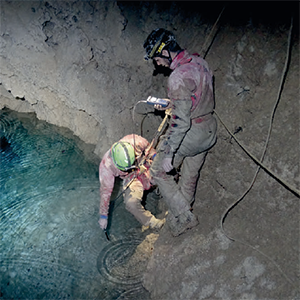Study of dilution processes of sulfidic aquifer hosted by the Fiume-Vento karstic complex, Frasassi (Central Italy)

All claims expressed in this article are solely those of the authors and do not necessarily represent those of their affiliated organizations, or those of the publisher, the editors and the reviewers. Any product that may be evaluated in this article or claim that may be made by its manufacturer is not guaranteed or endorsed by the publisher.
Authors
Sulfuric acid caves are widespread worldwide. In Central Italy, the Fiume-Vento karstic complex represents the most important active hypogenic cave system hosting several interconnected lakes where groundwater moves towards sulfidic springs emerging along the Sentino Stream. Stratification and dilution phenomena between freshwater and sulfidic water occur in many underground lakes, even if they remain still open if these processes are driven by stream-aquifer interaction or dripping water. The speleological knowledge coupled with geochemical surveys can help study groundwater circulation in the karst system’s inner and outer portions. The geochemical analyses on water samples taken along the Sentino Stream, inside the caves (dripping and lakes water) and in sulfidic springs allow establishing the origin of the dilution water in the dripping water. However, stream-aquifer interactions cannot be excluded during flood events. Using the tracer masse balance method (chloride and sodium ions), the discharge of the sulfidic springs ranges between 65 and 11 L/s. The results presented in this study may help understand groundwater circulation and dilution phenomena in other karst systems characterised by sulfuric acid speleogenesis type.
How to Cite

This work is licensed under a Creative Commons Attribution-NonCommercial 4.0 International License.
PAGEPress has chosen to apply the Creative Commons Attribution NonCommercial 4.0 International License (CC BY-NC 4.0) to all manuscripts to be published.














